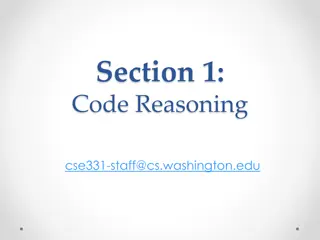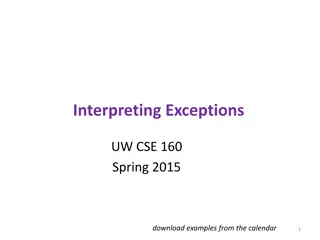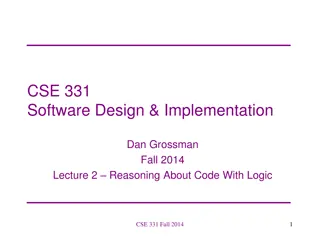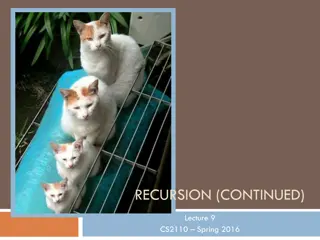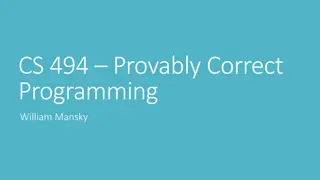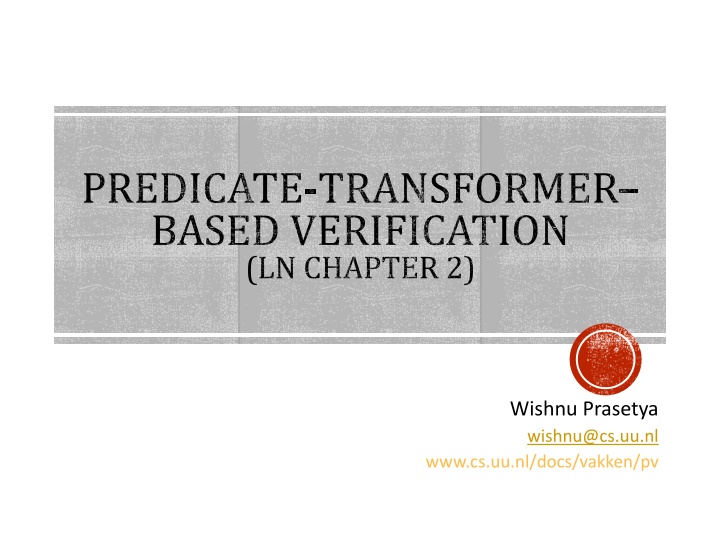
Predicate Transformer Based Verification Overview
Explore the concept of Predicate Transformer Based Verification in this comprehensive guide covering topics like Hoare Logic, Hoare Triples, Specifying Programs, and more. Learn how to mechanically verify real programs using Predicate Transformers and Guarded Command Language.
Download Presentation

Please find below an Image/Link to download the presentation.
The content on the website is provided AS IS for your information and personal use only. It may not be sold, licensed, or shared on other websites without obtaining consent from the author. If you encounter any issues during the download, it is possible that the publisher has removed the file from their server.
You are allowed to download the files provided on this website for personal or commercial use, subject to the condition that they are used lawfully. All files are the property of their respective owners.
The content on the website is provided AS IS for your information and personal use only. It may not be sold, licensed, or shared on other websites without obtaining consent from the author.
E N D
Presentation Transcript
PREDICATE-TRANSFORMER BASED VERIFICATION (LN CHAPTER 2) Wishnu Prasetya wishnu@cs.uu.nl www.cs.uu.nl/docs/vakken/pv
PLAN Hoare logic Verification using predicate transformers Verification with Guarded Command Language (GCL) Objects and exceptions Should at end give an answer to how to mechanically verify a real program . 2
SPECIFYING PROGRAMS We can use Hoare triples : { true } plusOne(x) body { return = x+1 } { #S>0 } max(S) body { return S /\ ( x: x S : return x) } total and partial correctness interpretation. 3
HOARE LOGIC Provides a set of inference rules to prove the validity of Hoare triples. Example: O P , { P } S { Q } ------------------------------------------------ { O } S { Q } Note : LN uses the notation O P 4
THE LOGICS GENERAL IDEA: BREAK IT DOWN! { P } S1 { Q } , { Q } S2 { R } --------------------------------------------------------- { P } S1 ; S2 { R } { P /\ g } S1 { Q } , { P /\ g } S2 { Q } ---------------------------------------------------------- { P } ifgthen S1 else S2 { Q } 5
ASSIGNMENT Eventually, everything boils down to assignments An assignment is correct if ..... P Q[e/x] --------------------------------------- { P } x:=e { Q } Note: this assumes that the assignment only changes the value of x (it does not silently affect other variables) 6
LOOP A loop is correct if you can find an invariant : P I { g /\ I } S { I } I /\ g Q ---------------------------------------- { P } whilegdo S { Q } E.g. a trivial loop: { k=1000 } while k>0 do k := k-1 { k=0 } 7
FEW MORE EXAMPLES { y=0 /\ k=0 } while k<10 do { y := y+2 ; k++ } { y = 20 } { y=0 /\ k=10 } whilek 0 do { y := y+2 ; k-- } { y = 20 } 8
FEW MORE EXAMPLES Home work: { s=false /\ k=0 } while k<#b do { s = s \/ b[k] ; k = k + 1 } { s = ( i: 0 i<#b : b[i]) } 9
PROVING TERMINATION (OF LOOP) Extend the previous rule to: P I { g /\ I } S { I } I /\ g Q { I /\ g } C:=m ; S { m<C } I /\ g m > 0 // m decreasing // m bounded below ---------------------------------------- { P } whilegdo S { Q } 10
EXAMPLE { x 0 /\ y 0 } while x+y>0 do { if x>0 then { x-- ; y := y+100 } else y-- } { x=0 /\ y=0 } 11
HOME WORK { x>1 } while x>0 do { if x>1 then x := x - 2 else x := x + 1 } { true } 12
HOARE LOGIC CANNOT BE DIRECTLY AUTOMATED Problem: { P } S1 { Q } , { Q } S2 { R } --------------------------------------------------------- { P } S1 ; S2 { R } Let s now look at predicate transformer-based verification . A predicate transformer is a function of type : Statement Predicate Predicate 13
FORWARD AND BACKWARD TRANSFORMER cp S P (forward) : transform a given pre-condition P to a post-condition. cp S Q (backward) : transform a given post-condition Q to a pre-condition. Do they produce valid (sound) pre/post conditions? Yes if : { P } S { cp S P } { cp S Q } S { Q } 14
FORWARD AND BACKWARD TRANSFORMER Sound and complete if : { P } S { Q } cp S P Q { P } S { Q } P cp S Q 15
WP AND WLP TRANSFORMER wpS Q : the weakest pre-condtion so that S terminates in Q. wlp S Q : the weakest pre-condition so that S, if it terminates, will terminate in Q. wlp = weakest liberal pre-conidtion. Though, we will see later, that we may have to drop the completeness property of wp/wlp,but we will still call them wp/wlp. 16
GUARDED COMMAND LANGUAGE (GCL) Simple language to start Expressive enough to encode larger languages So that you can keep your logic-core simple Constructs assignment, seq, while, if-then-else var x in S , uninitialized local-var. asserte , assumee try-catch program decl, program call primitive types, arrays 17
WLP wlp skip Q = Q wlp (x:=e) Q = Q[e/x] wlp (S1 ; S2) Q = wlp S1 (wlp S2 Q) We don t need to propose our own intermediate predicate! Example, prove: { x y } tmp:= x ; x:=y ; y:=tmp { x y } 18
WLP wlp (asserte) Q = e /\ Q wlp (assumee) Q = e Q wlp (S [] T) Q = (wlp S Q) /\ (wlp T Q) With respect to Hoare triples these two are equivalent (any Hoare triple satisfied by one is satisfied by the other) : ifgthen S1else S2 (assumeg ; S1 ) [] (assume g ; S2 ) 19
WLP So, it follows: wlp (ifgthen S1else S2) Q = (g wlp S1Q) /\ ( g wlp S2Q) Note : it is equivalent to (g /\ wlp S1Q) \/ ( g /\ wlp S2Q) 20
FORMULA GROWTH Note that wlp of if-then-else duplicates Q (2x). So a series like: wlp ( ifgthen S1 else S2 ; ifhthen S3 else S4 ; ifI then S5 else S5 ) Q will duplicate Q 8x. (exponential growth in the size of the resulting wlp) 21
PATH-BASED VERIFICATION Any program S that does not contain a loop or recursion can be equivalently decomposed into linear program paths . Example : ifgthen x:=e1else x := e2 ; ifhthen y:=e3else y := e4 Can be decomposed to: 1. assume g ; x:=e1 ; assume h ; y := e3 2.assume g ; x:=e1 ; assume h ; y := e4 3. assume g ; x:=e2 ; assume h ; y := e3 4. assume g ; x:=e2 ; assume h ; y := e4 22
PATH-BASED VERIFICATION {P} S {Q} is valid forall program path ? of S: {P} ? {Q} is valid. E.g. to verify : { P } 1. { P } assume g ; x:=e1 ; assume h ; y := e3 { Q } 2. { P } assume g ; x:=e1 ; assume h ; y := e4 { Q } 3. { P } assume g ; x:=e2 ; assume h ; y := e3 { Q } 4. { P } assume g ; x:=e2 ; assume h ; y := e4 { Q } ifgthen x:=e1else x := e2 ; ifhthen y:=e3else y := e4 { Q } Each is reducible to pred. logic formula. We can automate this! This approach of verification is also called symbolic execution , because it as if we symbolically execute each control path in the target program. The number of paths can still be a lot, but we can verify them incrementally, and even choose which ones to verify. 23
UNFEASIBLE PATH Consider as an example of program path (recall that the assumes came originally from branch-guards) : { P } assume g ; x:=x+1 ; assume h ; y := x { y>z } C1 = P /\ g C2 = P /\ g /\ h[x+1/x] A program path can turn out to be unfeasible if no actual execution can trigger it. This happens if one of its branch-guard is unfeasible towards the path pre-condition (P above) : Condition g above is unfeasible if C1 is unsatisfiable Condition h is unsatisfiable if C2 in unsatisfiable Verifying an unfeasible path is waste of effort, but checking if a path in unfeasible also takes effort (above, you need to check C1 and C2). 24
FORWARD SYMBOLIC EXECUTION Forward symbolic execution: executing a program path, using variables to symbolically represent all possible inputs. We maintain a symbolic state. Initially x x0 y y0 z z0 Constraint: x0=y0 { x=y } x:=x+2 ; z:= x-1 { x>y } 0 1 2 3 x x0 means the variable x has the value x0. x0, y0, z0 : fresh variables representing initial values of x,y,z. Constraint is a condition that the symbolic values must satisfy, e.g. because it is imposed by the program s pre-condition. 25
BACKWARD VS FORWARD SYMBOLIC EXECUTION Forward symbolic execution: we execute a program, taking a formula as its input : (0) x x0 , y (1) x x0+2 , y (2) x x0+2, y y0 , z y0 , z y0, z z0 /\ x0=y0 z0 /\ x0=y0 x0+2-1 /\ x0=y0 { x=y } x:=x+2 ; z:= x-1 { x>y } 0 1 2 3 The Hoare triple on the left is valid if and only if the final symbolic state implies the post-condition. That is, if this is valid: x=x0+2 y=y0 z=x0+2-1 x0=y0 x=y 26
BACKWARD VS FORWARD SYMBOLIC EXECUTION Consider again the verification of: { x=y } x:=x+2 ; z:=x-1 { x>y } x=y x+2>y wlp-based verification Wlp-based. The program is valid iff x=y x+2>y Forward symbolic execution: the program is valid iff x=x0+2 y=y0 z=x0+2-1 x0=y0 x=y 27
BACKWARD VS FORWARD TRANSFORMATION Backward execution yields: x=y x+2>y. Forward execution yields: y=y0 /\ x0=y0 /\ x = x0+2 /\ z=x0+2-1 x>y Backward transformation: yields cleaner formulas, containing only conditions relevant towards the post-cond. Forward transformation The direction is more intuitive The intermediate formulas also produce conditions that correspond to the feasibility of each branch-guard (1x, the blue box above), so you can immediately check the guard feasibility. Note we can also check this via wlp; it is just that we need more staging in the corresponding symbolic execution. 28
CAN WE PROVE THE SOUNDNESS AND COMPLETENESS OF THE WLP TRANSFORMER ? Yes, e.g. wrt a denotational semantic. I will just give a sketch of how to do this. Consider the following semantical domains: State : the space of all possible program states. val : the space of all possible values of program variables Note: Chapter 1 and 2 propose two different representations of states. They are both usable, as they both support state query and update. 29
THE SEMANTIC OF EXPRESSIONS AND PREDICATES : expr (State val) : Pred (State bool) // overloading e.g. x>y = ( s. s x > s y) Note that P:State bool can equivalently be seen as a set of all the states on which P is true: P as a set = { s | s State /\ Ps } Predicate operators translate to set operators, e.g. /\, \/ to , negation to complement wrt State. This ordering: P Qis valid translates to P Q 30
THE SEMANTIC OF STATEMENTS ? : stmt (State State) Alternatively: ? : stmt (State Pow(State)) to allow non-determinism. where Pow(State) is the domain of all subsets of State. On this domain, we have: 31
THE SEMANTIC OF STATEMENTS (DETERMINISTIC) ? skip = (?s. s) ? x := e = (?s. update s x ( e s) ) ? S1 ; S2 = (?s. ? S2 (? S1 s) ) 32
SEMANTIC OF HOARE TRIPLE (DETERMINISTIC) : Hoare-triple bool ( {P} S {Q} ) = s: P s : Q (? S s) wlp is sound and complete if: {P} S {Q} if and only if P wlp S Q is valid In comes down to proving that: for all state s, and post- cond Q: Q (? S s) if and only if wlp S Q s Can be proven inductively over the stucture of S. 33
DEALING WITH LOOP Unfortunately, no general way to calculate wlp of loops. For annotated loop, let s define : wlp (inv I while g do S) Q = I , provided I /\ g Q I /\ g wlp S I 34
WHAT IF THERE IS NO I ANNOTATED ? Heuristics to construct invariants e.g. based on the form of the post-condition not in scope. Dynamically infer invariants not in scope. Non-heuristic approaches, simple; can be used as starting points. Fix point based Unfolding 35
WLP AS FIX POINT loop Note this first: whilegdo S if g then { S ; whilegdo S } else skip let W = wlploopQ. = (g wlp S (wlploop Q)) /\ ( g Q) = (g /\ wlp S (wlploop Q)) \/ ( g /\ Q) W F(W) We are looking for the weakest solution of W = F(W) 36
THE DOMAIN OF STATE PREDICATES, POW() Suppose (set of all states) = { s,t,u }. The domain Pow( ), ordered by : { s,t,u } top ( ) ... corresponds to true related by {s,t} {s,u} {t,u} {t} {u} {s} bottom ( ) .... corresponds to false X Y (union) acts as the least upper bound of X and Y X Y (intersection) acts as the greatest lower bound of X and Y 37
SOME BIT OF FIX POINT THEORY (A, ) where is a p.o., is a complete lattice, if every subset X A has a supremum and infimum. Supremum = least upper bound = join Infimum = greatest lower bound = meet /\ X So, we will also have the supremum and infimum of the whole A, often called top and bottom . Let f : A A. An x such that x = f(x) is a fix point of f. Knaster-Tarski. Let (A, ) be a complete lattice. If f : A A is monotonic over , and P is the set of all its fix points, then P is non-empty, and (P, ) is a complete lattice. (thus, both P and P are also in P). X X \/X 38
SOME BIT OF FIX POINT THEORY The domain (pow( ), ) is a complete lattice. = top = bottom A B : least upper bound (\/) A B : greatest lower bound (/\) So, if F defined before is monotonic within this domain, then it has a greatest fix-point. Is F monotonic ? Is wlp monotonic ? 39
SOME BIT OF FIX POINT THEORY Consider now f : pow( ) pow( ). It is -continuous if for all decreasing chain X0 X1 X2 ... : f ( X0 X1 ... ) = f(X0) f(X1) ... If f is -continuous, it is also monotonic. Is wlp -continuous ? 40
FP ITERATION Define: f 0(X) = X , f k+1(X) = f ( f k(X)) Suppose f is -continuous. Consider the series f 0 ( ) , f 1( ) , f 2( ) ... Corollaries: f is also monotonic. The series is a decreasing chain. ? = f 0( ) f 1( ) f 2( ) ... is a fix point of f. ? is the greatest fix point of f. 41
FP ITERATION How to compute { f k ( ) | k 0 } ? compute f 0, f 1, f 2, ... but notice you only need to keep track of the last. X:= ; while X f(X) doX := f(X) Will give the greatest FP, if it terminates. For wlp : W := true ; while W F(W) doW := F(W) where F(W) = (g /\ wlp S W) \/ ( g /\ Q) 42
EXAMPLE 1 while y>0 do{ y := y 1 } { y=0 } Q is y=0 W0 = true W1 = (y>0 /\ wlp S W0) \/ ( (y>0) /\ y=0) = (y>0 /\ true) \/ (y=0) = y 0 W2 = (y>0 /\ y-1 0) \/ ( (y>0) /\ y=0) = y 1 \/ y=0 = y 0 W2 = W1 43
EXAMPLE 2 while y>0 do{ y := y 1 } { d } Q is d -- c,d are bool vars W0 = true W1 = (y>0 /\ wlp S W0) \/ ( (y>0) /\ d) = (y>0 /\ true) \/ (y 0 /\ d) W2 = (y>0 /\ wlp S W1) \/ (y 0 /\ d) = (y>0 /\ y>1) \/ (y=1 /\ d) \/ (y 0 /\ d) W3 = (y>2 ) \/ (y=2 /\ d) \/ (y=1 /\ d) \/ (y 0 /\ d) does not terminate 44
EXAMPLE 3 while y>0 do { assertd; y := y 1 } { d } Q is d -- c,d are bool vars W0 = true W1 = (y>0 /\ wlp S W0) \/ ( (y>0) /\ d) = (y>0 /\ d) \/ (y 0 /\ d) = d W2 = (y>0 /\ wlp S W1) \/ (y 0 /\ d) = (y>0 /\ d) \/ (y 0 /\ d) = d W2 = W1 45
FINITE UNFOLDING Define (g,S) = assert g [while]0 [while]k+1(g,S) = if g then { S ; [while]k(g,S) } else skip while 0 while k+1(g,S) = if g then { S ; while k(g,S) } else skip (g,S) = assume g Iterate at most k-times. Iterate at most k times, then miracle. 46
REPLACING WHILE WITH [WHILE]K { P } while y>0 do{ y := y 1 } { y=0 } wlp ([while]2(y>0 , y := y 1)) (y=0) = ( y=2 \/ y=1 \/ y=0 ) Works if P says y is exactly that (0,1,2). Does not work if Pis e.g. y=3 or y 0 Such unfolding produces sound wlp, but incomplete. 47
REPLACING WHILE WITH WHILE K wlp ( while 2(y>0 , y := y 1)) (y=0 /\ b) = y>2 \/ (y=2/\b) \/ (y=1/\b) \/ (y=0/\b) P : y=0 \/ y=1 ... works P : y 0 ... works as well This unfolding yields wlp which is complete but unsound. So, if P W, W is the above wlp, is valid, we don t know if the original specification is also valid. However, if P W is invalid, then so is the orig. spec. 48
VERIFICATION OF OO PROGRAMS GCL is not OO, but we can encode OO constructs in it. We ll need few additional ingredients : local variables simultant assignment program call array object method 49
LOCAL VARIABLE wlp (var x in x:=1 ; y := y+x end) (x=y) Rename loc-vars to fresh-vars, to avoid captures: wlp (var x inx :=1 ; y := y+x end) (x=y) Let s try another example : wlp (var x inassumex >0 ; y := y+x end) (x=y) Note that if x is fresh we can alternatively treat this as: assumex >0 ; y := y+x 50


